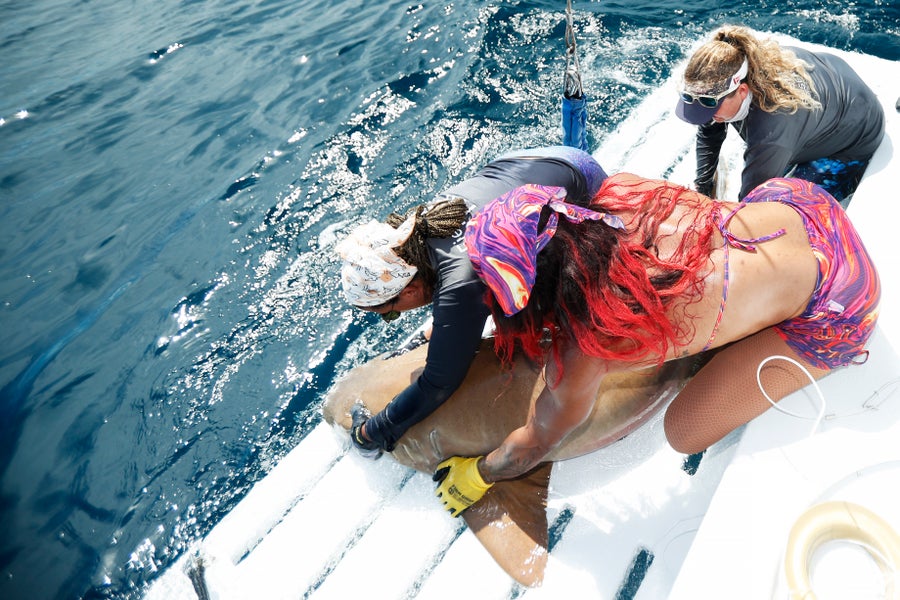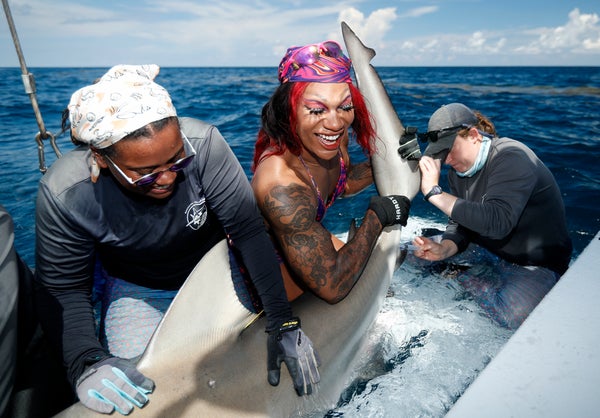It starts like any other day on the water for the Field School, a marine research and education organization based in Miami. Scientists and volunteers cram into the main cabin of the RV Garvin, a 55-foot converted yacht that bears an unsettling resemblance to the boat in Jaws. A Field School scientist holds a pink plush shark and gestures to its fins and tail, explaining the data that we will be collecting.
Soon we’re cruising through calm seas off Florida’s Atlantic coast. Volunteers toss big steel hooks baited with bloody chunks of bonito fish overboard, and heavy concrete anchors pull the bait to the sea floor, where it will hopefully attract some of the region’s largest sharks.
Then the music starts.
On supporting science journalism
If you're enjoying this article, consider supporting our award-winning journalism by subscribing. By purchasing a subscription you are helping to ensure the future of impactful stories about the discoveries and ideas shaping our world today.
The cabin door pops open, and Miss Toto—a tall, muscular drag queen with a long red-and-blonde wig and a colorful ruffled costume reminiscent of a tropical fish—emerges and takes the makeshift stage. She dances and lip-synchs to Nicki Minaj’s “Starships” as the boat rolls with the waves. She’s soon joined by Viola Putx, who is dancing energetically to Bad Bunny in heavy black boots, a spiked collar and pointy elf ears, and finally by Opal Am Rah in a tight pink dress, performing (what else?) Céline Dion’s “My Heart Will Go On”—because this is no ordinary shark tagging expedition. This is Drag ’n Tag.
Nine years ago, Toto was a master’s student at the University of Miami. There she met Catherine Macdonald, head of the university’s shark research program and director of the Field School. Though Toto was studying aquaculture, she had always been interested in sharks—so she joined Macdonald’s shark tagging program as an intern.
Around that time, Miss Toto also began performing in drag shows. “It was an outlet to meet other queer people,” she says. “It was the first time I had a group of friends outside of school or sports.”
After graduating, Toto felt mentally “tapped out” in science and needed a break. She worked as an educator at a science center while doing drag shows on the side before she decided to really focus on her craft. Now Toto is a full-time drag queen and DJ based in Chicago. But she still gets out on the boat with the Field School every time she returns to Miami.
She and Macdonald started Drag ’n Tag expeditions in 2021 to showcase queerness in marine science. “It can be hard for queer people in this field,” Macdonald says. “Plenty of them are very quiet about it. We want to create welcoming spaces for visual queerness.” Ticket sales and other donations for the event also raise money to support Pridelines, a charity that offers services and support for LGBTQ+ youth and community in South Florida.

Miss Toto (center), along with Webber-Schultz (left) and University of Miami master’s student Jenny Norcross, tag and release a nurse shark. Credit: Cliff Hawkins/Field School
After the Garvin’s onboard drag show, it’s time to go to work. The boat circles back to the string of buoys marking the hooks, and we begin hauling them in, alert for the tug of a shark on the line. The first catch is a two-meter-long, sandy-brown nurse shark. It is pulled up onto a floating platform off the back of the boat and held steady by Miss Toto and the Field School staff so the volunteers can begin collecting data.
The amateur taggers must work fast despite their inexperience; the goal is for each fish to spend no more than six minutes out of the water.
“I was so focused on getting the measurements right, I don’t remember much!” says volunteer Cristhian Rojas, a business development manager for a flooring company. He had the thrilling job of measuring the first shark’s length and girth. The animal’s skin felt softer than it looked, he says—rough in one direction and smooth in the other, like a cat’s tongue. Afterward other volunteers help swab the shark’s skin for bacteria and snip off a tiny piece of its dorsal fin for genetic analysis, while one of the professionals takes a blood sample.
As someone more used to hands-off whale watching trips, I can hardly believe that I’m getting down into the water next to a shark’s thrashing body. I am tasked with attaching the tag—a numbered piece of plastic that will identify the shark if it is ever captured again. Because nurse sharks have such tough skin, I use a mallet to tap the tag into the cartilage at the base of the dorsal fin. It feels a bit like driving a nail into a watermelon, but because sharks have fewer nerves than humans do and don't seem to feel pain the same way, the animals hardly notice.
The data we collect will contribute to shark population monitoring and research projects in Macdonald’s lab, which tracks how these animals respond to changes in their environment. “It’s very difficult to protect a species you don’t understand, so data on sharks can play a role in identifying essential habitats or potential threats,” Macdonald says.
Drag ’n Tag focuses not just on the sharks but also on the scientists doing the research. “Many in the queer community have had adverse experiences in marine science with people who don’t think we belong,” says Jenny Norcross, a master’s student in Macdonald’s lab who studies Atlantic guitarfish and introduced herself to those on the boat as a “raging lesbian.” “So events like this that bridge the gap between the community and science are immensely important.”
There are few data on LGBTQ+ people in marine science, but research shows that the field lacks racial and gender diversity. Nonwhite and nonmale students and researchers have reported that they often do not feel welcome in the field and that they have faced overt discrimination, microaggressions and a lack of recognition for their work. Many people from underrepresented groups who have left marine science say a shortage of support contributed to their decision.
“Marine science, and especially shark science, is a very white male path,” Toto says. “So showing that there are people of color, there are women [and] there are queer people is important.”
Amani Webber-Schultz, a Ph.D. student at the New Jersey Institute of Technology, studies how shark scales influence water flow—and has co-founded a nonprofit called Minorities in Shark Sciences. “I always wanted to be a shark scientist but didn’t see anyone who looked like me,” she says. “I hope this helps dissipate stereotypes like ‘Black people don’t like water’ and gets people thinking about what diversity looks like.”
Today such efforts at inclusion often come with risk. Drag ’n Tag was never intended to be a political statement—but it is taking place in Florida, where simply existing as queer has become an inherently political act. The state has been turning into an increasingly hostile place for queer people; its infamous “Don’t Say Gay” law limits classroom instruction on sexual orientation and gender identity, and the state has also imposed restrictions on gender-affirming treatments for minors, as well as on drag shows, bathroom usage and the pronouns that kids can use in school.
Such moves have made Drag ’n Tag fundraising all the more important to Pridelines, which is now barred from much of the work it used to do with schools. “All of the ways we used to reach out to at-risk youth were closed overnight,” says Daniel Molloy, Pridelines’ director of grants and programming. Drag ’n Tag provides “unrestricted funds that allow us to house young people overnight, provide meals for folks who sometimes have not eaten in days and [provide] transportation for people to get somewhere safe,” he says.
And some say the new restrictions have actually emboldened the queer community and its allies. “Because of the time and place, the impact [of Drag ’n Tag] has been bigger than we anticipated,” Toto says. “To have all of these people supporting us, giving the finger to the politicians, is incredible.”
The tense atmosphere has, however, made the event more frightening to hold, Macdonald says. The Garvin flies both a rainbow Pride flag and a Black Lives Matter flag, prompting the occasional shouted slur. “We’re still figuring out what protecting our students looks like,” Macdonald adds. “It’s important to make our values clear, but we don’t want people screaming at them.”
But the only screaming today (besides from the audience during the drag show) comes from a family on a passing boat, whose children recognize Miss Toto and call out happy greetings. “I never expected that!” Toto says, with a huge grin and a hint of tears in her eyes.
Throughout the afternoon, we catch, sample and tag two more nurse sharks and a slate-gray bull shark. As we finally return to the marina in the baking late-afternoon heat, everyone aboard, scientists and civilians alike, buzzes with the excitement of the day. Miss Toto is already looking forward to next year. “This day is about joy and celebration,” she says, “and making a statement that love and community will always conquer hate.”
